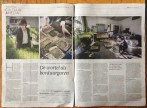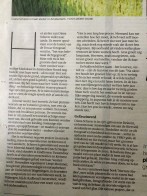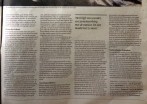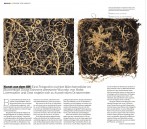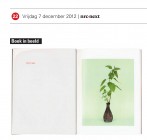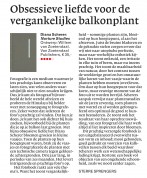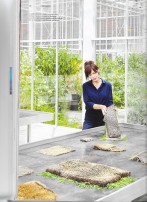

#1
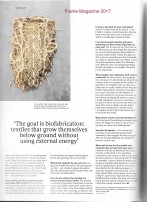

#2
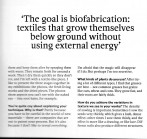

#3
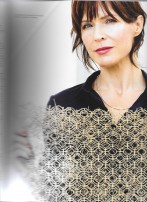

#4
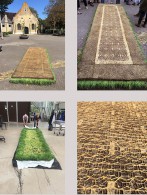

#1
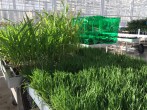

#2


#3
Wageningen & Research
resource.wur.nl/en/science/show/Weaving-with-roots.htm
Anyone who has ever dropped a pot plant gets the picture. The clump of white roots has taken on the shape of the broken pot. Petrified life force. Quite beautiful really. This is more or less how it started for the German artist Diana Scherer. ‘I was fascinated by it and I took pictures and hung them up in my studio. Then I thought: what can I do with this?’ This turned out to be the start of a quest, the results of which so far can be seen in Impulse, where Scherer’s intriguing root art will be exhibited for another month.
The clumps of roots inspired Scherer to create a series of root vases: flowers in vases made out of their root systems. ‘What happened was that I discovered that every plant has its own type of roots. Every root system is different in shape and structure. Chamomile, for instance, has rough, very woolly roots. Grass has silky, white roots. One plant only makes thick ropes while another makes those tiny little hairy roots, making it rather cuddly.’
Scherer spent two summers experimenting in her studio in Amsterdam. ‘And that was not easy at all. Not every plant wants to be forced into any old vase. I had to really research that, and lots of things went wrong at first. Roots that rotted away, for instance, because it was too wet. In the end I made a book containing 32 different plants.’

Experimenting
But the real manipulation was still to come at the point. It became clear to Scherer that she wanted to carry on working on the roots after the vase phase. At some point it occurred to her that the roots could be used as yarns. ‘Then I got the idea that I wanted to weave. I thought: that’s cool, I’m going to make a textile out of this.’ Because if roots can take on the shape of a vase, why not another form imposed on them from outside?
It took Scherer over a year of experimenting before she ‘had something to show for it that looked a bit presentable.’ Exactly how she managed that is her secret. ‘I worked on this for a very long time and I don’t want other people imitating it. If someone wants to do it, they’ll have to figure it out for themselves. It’s a bit like a painter who worked for three years to get the perfect blue. That’s a trade secret, I’m not giving it away. What is more, there is potential here for new materials.’
‘Also, as an artist I feel it detracts from the magic if you know how I did it,’ adds Scherer. ‘I feel I’m betraying my work if I tell people how I do it.’ Without going into details, then, what it boils down to is that Scherer gets roots to grow in a template-like mould. And the roots do that, she explains, because they are continuously searching for food. ‘What they really want is to grow downwards in search of water and nutrients. They search in every direction and go wherever I give them space to go. The dynamics and power of the growth process are incredible.’

Manipulation
Scherer mainly works with oats and wheat. ‘Oats can be sown very close together, which gives you an extremely high volume of roots. And oats grow fast as well. In the summer I can sometimes get a pattern within two weeks. And because it grows so quickly, the roots are still very young as well. Young roots are very beautiful and have tiny little hairy roots which are rather cuddly.’ This pattern on the underside is what it is all about. When that carpet is ready, Scherer turns the ‘lawn’ over and the result is recorded with a technical camera in great detail.
Scherer’s work is all about manipulation, human control over nature. The photos show root fibres with clear-cut geometric patterns. The work raises questions about the relationships between people and the natural world. Can this still be called nature, for instance? Scherer: ‘I change a natural fibre in the root system into an artificial and textile-like fibre. That is what you do as an artist: change reality into what you want it to be. I send the roots in all directions. Maybe that’s not very nice or respectful. If I wanted to respect the will of the roots, I wouldn’t make them grown in templates. I impose my will on them and domesticate them, but I’m not ashamed of that. Manipulation is the artist’s challenge. I make nature do my bidding. And we all do that actually. Everyone prunes and mows, and we all want things to look exactly as we want them. That’s manipulation too. What I do is no different really, it’s just that you haven’t seen this before.’

Intelligent plants
There are a couple of withered flowers on the table in Scherer’s studio. ‘I think those plants are very cross with me,’ she announces suddenly. ‘Because I neglected them so badly. Plants are extremely sensitive. Especially underground. Did you know that mother trees feed their young nearby through fungi? When animals eat from plants, those plants send out signals which cause other plants to generate toxic substances that kill the animals. That’s smart! Yes, I do believe plants are intelligent. As an artist I can afford to believe that. I don’t believe a plant will every win the Nobel Prize, mind you, but I do think this kind of plant response is smart. It would be stupid of plants not to warn each other. Why shouldn’t plants have intelligence? I’m convinced of it. I think there is much more intelligence there than we realize.’
That’s smart! Yes, I do believe plants are intelligent
Good insulation material
Scherer’s work is attracting plenty of interest. She won the New Material Award at the latest Dutch Design Week in Eindhoven. Scherer’s root fibres hold out the promise of exciting new materials, say experts. ‘But it is not just new and fun,’ says Scherer. ‘Roots store CO2 too. That is interesting in ecological terms. The nice thing about it is that the material creates itself as it grows. Unlike other natural materials such as coconut fibre or cotton, you don’t have to weave it afterwards to get your product. Roots weave themselves, and that makes them an attractive prospect.’

Together with an ecologist from Radboud University in Nijmegen, Scherer is going to look for stronger roots and ways of conserving fibres. ‘Maybe it will become a kind of insulation material,’ she thinks aloud. ‘But then material you can stick onto a wall instead of behind it. Insulation which is so attractive you want to be able to see it. But this idea is still in its infancy. I’m looking for business partners.’
Root dress
There is another new challenge in the patterns Scherer works with. Up to now, Scherer found most of her inspiration in basic geometrical figures, which occur all over the place in nature. ‘The hexagon, for example, which you find in honeycombs, crystals or organic molecules. And shapes from Art nouveau, which was also very much inspired by nature. But the next step is for me to make my own patterns, together with a mathematical pattern designer. It needs to be taken a step further, so that I don’t keep it to myself anymore.’
Oh, the possibilities are endless
The possibilities for playing with roots are endless. Her first attempt at a dress made of roots lies on the table beside her. It looks pretty wearable. She also wants to work with several different kinds of roots at the same time, in her carpets. ‘A kind of intercropping. And I also want to work with several layers, for instance. Oh, the possibilities are endless.’
Diana Scherer’s exhibition Interwoven can be seen in Impulse on Wageningen Campus until Friday 3 February.
Root science
That Diana Scherer’s root art is on view in Wageningen is thanks to professor of Plant Ecology Liesje Mommer. At a symposium to mark the opening of the exhibition in December, several Wageningen researchers shed light on the wondrous world of roots, and Mommer was one of them.
Professor Mommer studies the interaction between plants and fungi in natural grasslands. Biodiversity plays an important role in this. The more species of plants the better. That is, the more different roots, the better. A greater wealth of species lead to higher productivity of the ecosystem. Mommer thinks that is because pathogenic fungi get less chance of doing their thing in soils with a variety of different root systems. It is harder for the fungi to find their favourite plants. ‘Lost in diversity,’ Mommer calls it. ‘There are so many signals, metabolic products and volatile substances given off by roots and bacteria, that pathogenic fungi lose their way.’
Another speaker at the symposium was assistant professor Jochem Evers of the Centre for crop systems analysis. Where artist Scherer forces roots to grow where she want them to, Evers seeks to model mathematically why roots of different species grow the way they do. The roots find their own way through a forest of stimuli. Evers starts simply with an established system of maize and beans, in which the yield is bigger when the two crops are grown together than when they are grown separately. The roots of beans excrete organic acids which make phosphate present in the soil dissolve. Maize then benefits from the available phosphate. And so the whole is more than the sum of the parts.
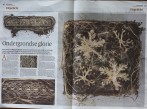

#1
De schoonheid van de wortelwereld
Kunstenares Diana Scherer dresseert plantenwortels zodat ze in fraaie vormen groeien. Tot grote vreugde van de wetenschappers die haar begeleiden: iederéén kan nu de schoonheid van de wortelwereld zien.
Als een plant zijn wereld zou beschrijven, zou hij dat misschien wel ondersteboven doen, en beginnen bij de wortels. Want leuk hoor, dat groen daarboven. Maar als je op zoek gaat naar de essentie van zo’n plant vlak dan de wortels niet uit.
‘Een hele wereld van interacties en gevechten met bacteriën en andere wortels speelt zich daar beneden af’, vertelt de Nijmeegse hoogleraar experimentele plantenecologie Hans de Kroon. ‘Die wortels zijn eigenlijk de hersenen van de plant’, zegt kunstenares en fotografe Diana Scherer. ‘Er gebeurt ontzettend veel onder de grond.’
Sinds enige tijd is Scherer u kunt de naam kennen van haar fotowerk voor de zaterdagbijlagen van deze krant die wereld aan het verkennen, vanuit het vernieuwde ‘wortellaboratorium’ van De Kroon, dat vandaag officieel wordt geopend in Nijmegen. Gesteund door de biologen en de conservator kunst en cultuur van het Radboud UMC probeert ze de wortels in kunstzinnige banen te leiden.
‘Het zijn eigenlijk een soort haren of draden. Dus misschien kun je ze zo modelleren dat ze een geheel vormen. Een weefsel, of een mat’, zegt de kunstenares. ‘We werken nooit op deze manier, maar we leren hier veel van’, zegt de wetenschapper. ‘Diana geeft uitdrukking aan de schoonheid van deze wereld, die wij in onze gedachten al hadden. Dit zijn zoekende, tastende organen, met zintuigen die hun omgeving waarnemen. Dat zie je hier uitgebeeld.’
Nog een heel gedoe om die zoekende en tastende organen een beetje in het gareel te houden, vertelt Scherer. ‘Eigenlijk groeien ze alle kanten op. Ze zoeken constant naar voedsel, donkerte, water. Als je ze op een sjabloon laat groeien, vullen die wortels tot mijn verbazing zelfs kleine holtes helemaal op.’
Nu ze de techniek na veel proberen onder de knie begint te krijgen, met grassen, tarwe en haver als leveranciers van de wortels, wordt het tijd voor de volgende stap: ‘Ik wil proberen de verhalen van boven te verbinden met de wereld onder de grond. Planten hebben vaak allerlei geneeskrachtige of rituele betekenissen. Die verhalen wil ik vertalen naar de wortels, tot uitdrukking brengen in de ondergrondse patronen.’


#1
Originally published by Joerg M. Colberg for Conscientious
Now that Academic Photography (“New Formalism”)—photography obsessed with its own navel, investigating its own process—has become so popular, seemingly, at least for some critics, pointing the way towards the medium’s future, we could have a nice re-iteration of the debate about beauty and photography. I have a hunch: this type of photography is here to stay, given it’s so appealing to academics. But for the rest of us it might soon evoke the same reactions we have when seeing, for example, wallpaper from the 1970s: kind of cool, yet also very clearly dated and passé. There we’re right in the messiness of talking about beauty today, in this still early 21st Century, because we’ve seen it all, and we’re all so ironic. In a nutshell, we’re more concerned about saying the right, proper things than addressing the issue(s).
Meaning we can’t really talk about beauty as in the quality present in a thing or person that gives intense pleasure or deep satisfaction to the mind, whether arising from sensory manifestations (as shape, color, sound, etc.), a meaningful design or pattern, or something else (as a personality in which high spiritual qualities are manifest)
(this courtesy of dictionary.com). My personal problem is, however, that I do that all the time.
In an MFA crit, for example, I’ll say “this is beautiful.” Inevitably someone will ask “why?”—and I’ll say “just look at it!” For me, that’s a perfectly convincing argument, in particular since it’s a setting where the participants are usually fairly close with regards to their artistic education and background: everybody has acquired the same tastes [I don’t want to overparse my own writing, but the plural is intentional here. As an MFA student you typically understand what is to be appreciated in, let’s say, the photography done by William Eggleston, even if you personally don’t like that work at all; and the same is true concerning many other photographic practitioners.], while, of course, their own personal preferences might differ. In other words, I should be able to concede that something is beautiful even if I don’t like it (and vice versa, even though that runs the risk of bringing us back into “ironic” territory. Then again, there also is the risk of ending in Academic Photography territory where a self-absorbed sincerity has replaced irony, with the rest of the mechanism still in place.)
It’s fairly simple to see what Diana Scherer’s Nurture Studies has to do with all of this. The book contains photographs of flowers or plants, the containers in which they were planted in removed. The containers’ shapes are left—we see the soil plus the roots, as if frozen in place, despite the fact that the restrictions that put them that way are gone. Still lifes of flowers/plants—let’s talk about beauty, shall we? Or maybe let’s at least acknowledge that beauty, in a very, very old-fashioned way, still occupies a place in art, in photography. These photographs of flowers against a simply, monochromatic background are beautiful. The book itself, as an object, is beautiful: produced with a Japanese stab binding, it’s a very modest, simple affair. Each photo page is preceded by another one of translucent paper that only has a date printed on it.
I will say this: as hard as it is to write about beauty, being in its presence is so gratifying—provided you give yourself permission to just do that.
Nurture Studies; photographs by Diana Scherer; 128 pages; van Zoetendaal; 2012
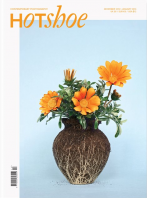

#1
“To collect photographs is to collect the world,” states Susan Sontag in her seminal book, On Photography, while for Diana Scherer, photography itself is “a way to collect”. In the production of her recent series, Nurture Studies (2010–2012), Scherer plays botanist/scientist/photographer/visual artist/collector as she researches, experiments and cultivates her ‘flower pieces’before organizing, archiving and producing photographs of her work.
The process is painstakingly slow and Scherer’s dedication to her work, both above and below ground, is evident. She started experimenting with plants and flowers, both of which are classified as flora, a couple of years ago with mixed results. “It took three years for me to discover the right working method and I had to try out lots of different flowers. Depending on the flower, I wait until the roots and the blossom are fully developed, which sometimes takes six months but other times just four. Often it doesn’t work out at all and, quite often, I found that the roots were too weak.” Scherer breaks the vase containing the plant the evening before to allow the soil and roots “to dry out a little” before photographing the ‘flower pieces’.
The series of photographs, Nurture Studies, is of cultivated plants, weeds and wild flowers that have been grown from seeds taken from her garden in the Netherlands. “The ambiguous nature of collecting intrigues me,” she says. “It involves loving attention as well as a fanatical desire to control. The collector documents and stores the object of his desire in a systematic and detached way. I also treat and present my work in an objective manner, even though working with nature has an emotional charge for me.”
Her previous bodies of work have involved high levels of control but with this series “the work creates itself”, up to a point, with Scherer manipulating “a little” and documenting the finished result. “In the work Nurture Studies, I also manipulate my tended flower pieces. Above ground, I let nature run its course. However, below the surface, by using a vase as a mould, I control the growth of the roots and the shape.” There is a tension in the beauty of the floral living sculptures where forces, such as freedom and restriction, letting go and control, produce a specimen that could also stand as a symbolic creative expression of the human situation.
Ikebana, the creative Japanese art of flower arrangement, is an inspiration, as is Bonsai, the practice of cultivating miniature trees. Ikebana has its own codes and conventions, is traditionally carried out in silence, and embodies a philosophical stance concerned with developing humanity’s closeness to nature. In these minimalist floral arrangements, the vase is an integral element in the composition. However, in Scherer’s work, there is no vase but the shape of the roots is an indexical sign of the particular container, or vase cast. As in the reproduction of sculptures, the mould contains and conceals the desired object until the cast is broken and the object is exposed. The absence of the vase thus reveals the intricate patterning of the cultivated root system, which is also a work of art. This further instills the series with notions pertaining to absence and presence. “I try to catch the moment that the plant is in its best shape,” she says. “The peak is not in my hands but in the hands of nature. Every plant has a moment when the blossom is fully grown, something that may only last for a couple of days after which it shrivels.” Transience, thus, becomes a further theme as each photograph captures and freezes what is, for Scherer, the peak of the plant’s life. That the sculptural ‘flower pieces’ are then placed against minimal backdrops and presented with simple captions only serves to highlight the constructed nature of the specimens and the role of artifice in the work.
“I’m interested in the age-old human practice of manipulating nature”, she explains. “There is a certain ambiguity that I find intriguing; the idea of loving care and, at the same time, ruthless manipulation. For example, the gardener who loves nature and nurtures the plants he desires also ruthlessly cuts, snips and manipulates them.” As to the final outcome, Scherer uses different methods of presentation aligned to the concept behind the series. “In some cases, prints are numbered and presented on walls or in showcases. In others, the end result is a book in which I organize and keep the images.” In keeping with the aesthetics of the work, the book is wrapped in a simple woodgrain-effect Japanese binding. Although the lineage of the work can be traced back to still life painting and photography as well as to illustrations from seventeenth-century botanical encyclopaedias that often depicted the root system as a further means of identification, Scherer’s work is firmly rooted in twenty-first century culture. She collects vases and uses photography as a means by which she can collect images of the plant. Both are tied to the culture of collecting, the collecting of culture and, with Nurture Studies, the cultured. And once Scherer has finished working with her ‘flower pieces’, they are returned to her garden. That Scherer has tended and reworked the root system before releasing the plant back to let nature run its own course, once again echoes the cyclical aspects of nature, of life and death, and of regeneration and degeneration.
Diana Scherer’s Nurture Studies, (2012) is published by Van Zoetendaal.

